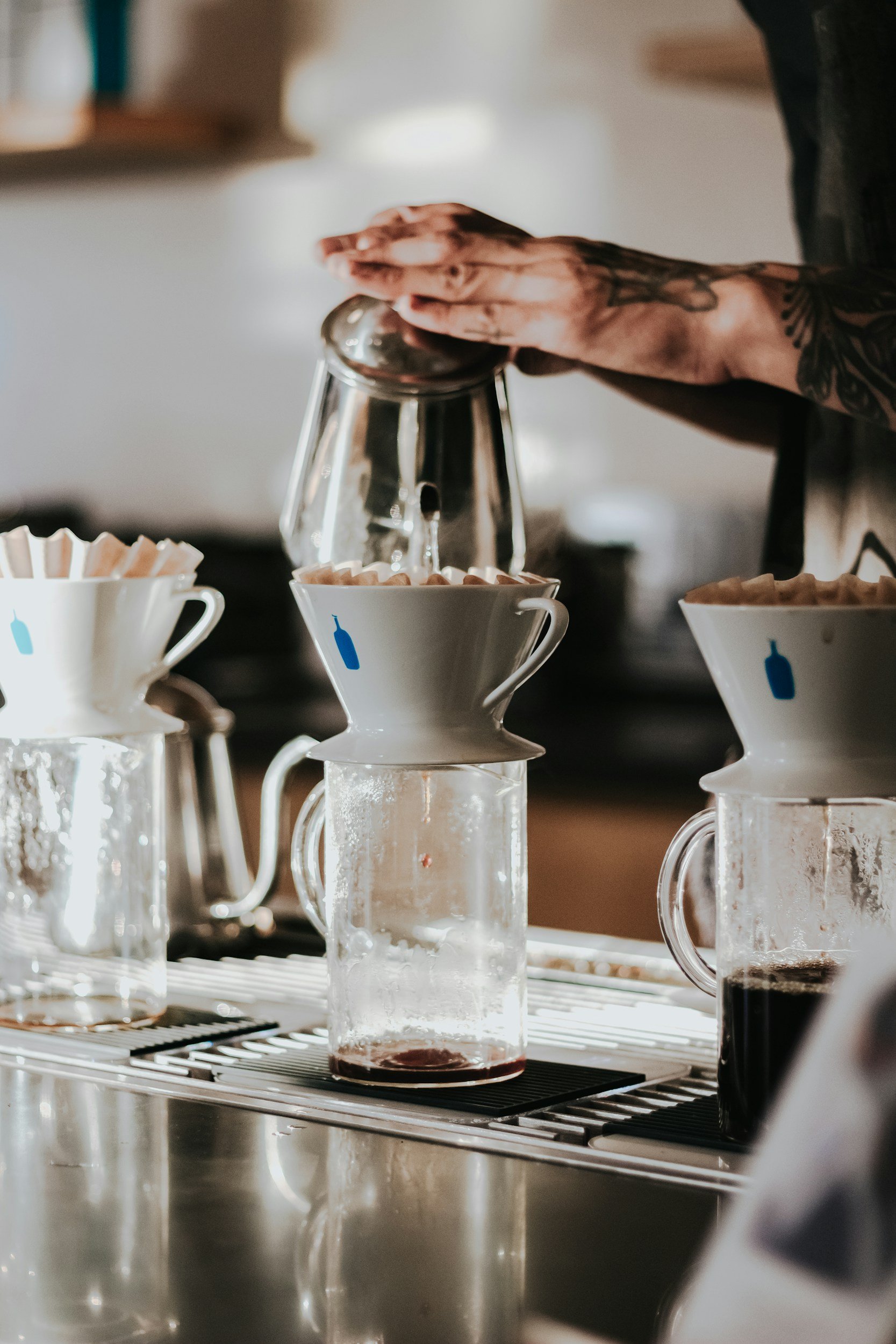Marketing Copy
Effective marketing content does not merely promote, it connects. In my freelance work, I have partnered with founders and creative teams to craft blogs, product stories, and brand messaging that reflect purpose, personality, and audience insight. These samples highlight how thoughtful language can elevate a brand’s voice while delivering value to readers and building trust.

Meet Blue Bottle Coffee
If you haven’t had the privilege of trying Blue Bottle Coffee, you’ve probably seen their compostable cups on Instagram or you may have even begun planning your next “business trip” around a visit to one of their fifteen locations in San Francisco, Los Angeles, or New York City. Maybe you’ve heard Blue Bottle described as the Apple of coffee or noticed that your local cafe is now touting a pour-over cup inspired by the method Blue Bottle imported from Japan and helped popularize nationwide. Blue Bottle Coffee is undoubtedly making its mark and, with some help from Perfect Coffee, you can taste why.
How did a musician turned entrepreneur, James Freeman, become the coffee guru of the start-up world? How did his stand at an Oakland farmer’s market grow into one of the most successful craft coffee companies out there? The answer isn’t very complicated: Blue Bottle makes spectacular coffee.
Dedicated to the bright, complex flavor of a fresh cup, Blue Bottle’s cafés serve only what’s been roasted within the past 48-hours. Drinking coffee at its freshest is a passion of ours as well, which is part of the reason Blue Bottle and Perfect Coffee make such a great pair. Using our technical know-how to measure, grind, and safeguard the freshness of Blue Bottle Coffee, we’ll make sure you enjoy it just as you’re meant to – at its absolute peak, regardless of your preferred brew method.
We’re thrilled to offer five of Blue Bottle’s carefully crafted, responsibly sourced, hands-down delicious roasts:
17ft Ceiling – A simply lovely espresso, it’s to the point but never overwhelming, tasting of caramel and nuts. Great for: When you need to wage war against the gophers who’ve staged a coup for your front lawn and you like your caffeine the classy Italian way.
Decaf Noir – A blend of organic water-processed beans from Africa and Central America, this coffee is strong, chocolatey, and you’d never believe it’s decaf. Great for: When you’re midway through a Humphrey Bogart film marathon, Earl Gray just won’t cut it, but you’d really love more than 3 hours of sleep tonight.
Giant Steps – Organic Sumatra and Congo beans combine to create this dark chocolate blend. Great for: When you start a new low-sugar diet or get called for jury duty and you need a hug, along with anything that resembles fudge.
Rwanda Kirezi – A buttery Rwandan coffee with a sharp floral taste and a citrusy finish. Great for: When your friends say all coffee tastes the same and you need a case-closing rebuttal that doesn’t involve actual butter.
Three Africans – This fruity blend of Ugandan and Ethiopian coffees makes for a cup that smells like chocolate and tastes both bright and creamy. Great for: Looking well-rested on Zoom or an uplifting break between paying bills and ruing the day you stopped responding to your third-grade pen-pal because at least they didn’t send you junk mail.
Check out our Blue Bottle Coffee options today! While we don’t promise you’ll be rid of a longing to visit Blue Bottle’s beautiful and welcoming cafés, we know you’ll enjoy the same fresh-tasting coffee wherever you are and regardless of the fact you probably don’t employ a live-in barista.
*Originally published for Perfect Coffee, LLC.

The Hole in Your Wellness Routine
You may be someone who scrutinizes the nutrition label of every item you pick up at the grocery store, who takes their daily vitamins in pill rather than gummy-bear form, who buys only organic produce, and who stays away from all processed foods and preservatives. Maybe you exercise regularly, spend time outdoors, and park inconveniently far from main entrances so that you can tally a few extra steps on your Fitbit or Apple Watch. You’ve taken charge of your health by controlling what factors you can, but what if there’s something you’re forgetting? What if it’s the one thing you’ve always taken for granted?
What if it’s as simple and pervasive as the air you breathe?
Apart from those with allergies, asthma, or other respiratory conditions, most of us are oblivious to the quality of air filling our lungs during those off-hours while we’re watching TV, sorting through bills, cooking, or even sleeping. Sure, we notice when smog makes the sky hazy or when dust piles atop our furniture because the weather has been dry or windy; but how many of us think about the way those circumstances affect our health and that of those around us?
You may have noticed that the health and wellness industry has grown rapidly over the last few years. Thanks to advances in technology and our better understanding of how diseases and other illnesses might be prevented or even treated through nutrition, stress reduction, and exercise, many of us are investing in tools to help us lead healthier, more enjoyable lives. This is a great start, but what portion of our efforts account for the fact that we are inhaling and exhaling thousands of times per day?
As more research reveals that indoor air quality can negatively affect everything from our mood to our lung capacity, we need to face the fact that ambivalence towards airborne contaminants can put us at risk for long-term health issues. Thinking about VOC’s (volatile organic compounds), ventilation, and humidity may not seem as commonplace as counting calories, building cardiovascular health, or brushing your teeth, but it’s by no means less important. Here are a few tips for incorporating air quality improvement into your wellness routine:
Understand the Stakes: Brush up on your knowledge of the adverse health affects associated with poor indoor air quality. To start, check out our article on VOC’s and the US Environmental Protection Agency’s IAQ information page.
Know Your Weaknesses: Identify your own bad habits with regard to keeping the air in your home clean. For example, knowing that you don’t vacuum often enough or that you light scented candles too regularly could help you target areas for improvement.
Set Goals and Make a Plan: Are you hoping to alleviate your worst allergy symptoms? Do you want to prevent mold by controlling humidity levels in your home? To protect your family from exposure to radon? All of the above? Make your goals concrete by writing them down and then come up with a methodology for achieving them. For information on improving the air quality of every room in your home, see our guide.
Track Your Progress: This is where we come in. Use Awair to monitor exactly how your new good habits are improving the quality of the air you’re breathing daily. See what works and what doesn’t and use those findings to determine your best healthy-air regimen.
*Originally written for Awair, Inc.

Taking Your Yoga Practice Alfresco
As winter fades to spring and we reluctantly begin appreciating the time change that wreaked havoc on our sleep cycles and dispositions, more of us are seeking excuses to get outside and earn our vitamin D the natural way.
Taking your yoga practice out of the studio and into the fresh air is a great way to change things up, but it requires a bit of planning and preparation. Here are a few tips for making the most of any outdoor environment:
Pack Ahead: Although, strictly speaking, one can practice yoga anywhere, doing it comfortably while outdoors means accounting for a few contingencies. Things you might want to pack include:
Extra towels (including one for wiping away sand or dirt)
Bug repellant (for obvious reasons)
Sunscreen (oil-free if you’re prone to slipping!)
Speakers (if nature sounds aren’t going to cut it while you flow)
Water (because there won’t be a water fountain or cup of tea waiting for you at the end of your practice)
Be the Early Bird: Enjoying a sunrise while you practice is only one benefit of getting up and outdoors early. When you’re not at risk of a painful sunburn or at the mercy of every toddler who kicks up sand while running past you, you’ll better appreciate your new surroundings for their tranquility and truly connect to the peace around you.
Find Stability: Whether you’re on the beach, at a trailhead, or in the park, your chances of finding an even surface to lay down your mat will be slim. Set up on a clearing that’s reasonably level, remove any rocks that could puncture your mat, and take every wobbly step as a challenge to improve your practice. Once you’ve finished a few flowing sequences, try balancing postures on the grass, atop a boulder, or ankle-deep in water. You might have trouble finding a drishti and you may feel insecure, but it’s a worthwhile experiment in feeling grounded amidst uncertainty.
Know Your Surroundings: Practicing yoga in a crowded studio or even in the comfort of our homes can lead us to ignore what our bodies need. When you take yoga outside and away form any normalized distractors, you’re forced to adjust your habits. You are given the opportunity to work on what matters most to your individual practice. If you have trouble relaxing, for example, pay attention to the way a breeze moves through trees, to the sound of waves marching to shore, or to the forgotten scent of nature apart from incense or essential oil diffusers. If you have trouble finding stability, try getting into tadasana barefoot on the dirt or into balasana with the sun at your back. Play with inversions on sloped ground, take all the time you can in restorative postures, and practice gratitude for fresh air when you practice pranayama.
Great weather can mean opportunity for your yoga practice so don’t miss the chance to get outside, soak it up, and share your outdoor adventures with us by tagging @yolohayoga on instagram!
*Originally published for Yoloha Yoga, LLC.